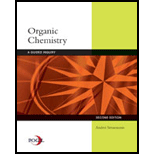
Concept explainers
(a)
Interpretation: The name that appears for a one-carbon branch should be given.
Concept introduction: Systematic way to name different organic compounds is
Rules for nomenclature of
1 The longest continuous carbon chain is identified first and named in accordance with number of carbon atoms present in it. For example, hydrocarbon with one carbon atom has prefix “meth”, that with two carbon atoms has prefix “eth”, that with three carbon atoms has prefix “prop” and so on. Suffix used for alkanes is “ane.”
2. Substituents attached to parent carbon chain are to be identified. These are named by removal of single hydrogen atom from carbon chain end and named by replacement of suffix “ane” by “yl.” For example if
3. Carbons of parent chain are named in such way that substituents acquire the lowest numbers.
4. If same substituent is present more than one time in molecule, it is represented by prefix “di”, “tri” and so on. It depends on number of times substituent occurs in molecule.
5. If two or more substituents are present in molecule, these are named in alphabetical order.
6. If carbon chains of same length exist in same molecule, chain with the largest number of side chains, followed by lowest number to substituents, chain with the greatest number of carbon atoms in smaller chain and chain with the least branched side chains are preferred over other ones.
7. Prefix “cyclo” is used if cyclic alkane is present in molecule.
(b)
Interpretation: The name that appears for the two-carbon branch should be given.
Concept introduction: Systematic way to name different organic compounds is IUPAC nomenclature. It has three parts: root name, suffix, and prefix.
Rules for nomenclature of alkanes:
1 The longest continuous carbon chain is identified first and named in accordance with number of carbon atoms present in it. For example, hydrocarbon with one carbon atom has prefix “meth”, that with two carbon atoms has prefix “eth”, that with three carbon atoms has prefix “prop” and so on. Suffix used for alkanes is “ane.”
2. Substituents attached to parent carbon chain are to be identified. These are named by removal of single hydrogen atom from carbon chain end and named by replacement of suffix “ane” by “yl.” For example if
3. Carbons of parent chain are named in such way that substituents acquire the lowest numbers.
4. If same substituent is present more than one time in molecule, it is represented by prefix “di”, “tri” and so on. It depends on number of times substituent occurs in molecule.
5. If two or more substituents are present in molecule, these are named in alphabetical order.
6. If carbon chains of same length exist in same molecule, chain with the largest number of side chains, followed by lowest number to substituents, chain with the greatest number of carbon atoms in smaller chain and chain with the least branched side chains are preferred over other ones.
7. Prefix “cyclo” is used if cyclic alkane is present in molecule.
Want to see the full answer?
Check out a sample textbook solution
Chapter NW1 Solutions
Organic Chemistry: A Guided Inquiry
- > You are trying to decide if there is a single reagent you can add that will make the following synthesis possible without any other major side products: 1. ☑ CI 2. H3O+ O Draw the missing reagent X you think will make this synthesis work in the drawing area below. If there is no reagent that will make your desired product in good yield or without complications, just check the box under the drawing area and leave it blank. Click and drag to start drawing a structure. Explanation Check ? DO 18 Ar B © 2025 McGraw Hill LLC. All Rights Reserved. Terms of Use | Privacy Center | Accessibilityarrow_forwardDon't use ai to answer I will report you answerarrow_forwardConsider a solution of 0.00304 moles of 4-nitrobenzoic acid (pKa = 3.442) dissolved in 25 mL water and titrated with 0.0991 M NaOH. Calculate the pH at the equivalence pointarrow_forward
- What is the name of the following compound? SiMe3arrow_forwardK Draw the starting structure that would lead to the major product shown under the provided conditions. Drawing 1. NaNH2 2. PhCH2Br 4 57°F Sunny Q Searcharrow_forward7 Draw the starting alkyl bromide that would produce this alkyne under these conditions. F Drawing 1. NaNH2, A 2. H3O+ £ 4 Temps to rise Tomorrow Q Search H2arrow_forward
 Organic Chemistry: A Guided InquiryChemistryISBN:9780618974122Author:Andrei StraumanisPublisher:Cengage Learning
Organic Chemistry: A Guided InquiryChemistryISBN:9780618974122Author:Andrei StraumanisPublisher:Cengage Learning
